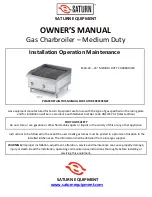
61
A.
COMBUSTION
1. NOZZLES — Although the nozzle is a relatively
inexpensive device, its function is critical to the successful
operation of the oil burner. The selection of the nozzle
supplied with the MPO-IQ boiler is the result of extensive
testing to obtain the best flame shape and efficient
combustion. Other brands of the same spray angle and
spray pattern may be used but may not perform at the
expected level of CO
2
and smoke. Nozzles are delicate
and should be protected from dirt and abuse. Nozzles are
mass-produced and can vary from sample to sample. For
all of those reasons a spare nozzle is a desirable item for
a serviceman to have.
2. FLAME SHAPE — Looking into the combustion
chamber through the observation port, the flame should
appear straight with no sparklers rolling up toward the
crown of the chamber. If the flame drags to the right or
left, sends sparklers upward or makes wet spots on the
chamber walls, the nozzle should be replaced. If the
condition persists look for fuel leaks, air leaks, water or
dirt in the fuel as described above.
3. FUEL LEAKS — Any fuel leak between the pump
and the nozzle will be detrimental to good combustion
results. Look for wet surfaces in the air tube, under the
ignitor, and around the air inlet. Any such leaks should
be repaired as they may cause erratic burning of the fuel
and in the extreme case may become a fire hazard.
4. AIR LEAKS — Any such leaks should be repaired, as
they may cause erratic burning of the fuel and in extreme
cases may become a fire hazard.
5. GASKET LEAKS — If 11.5 to 12.5% CO
2
with a #1
smoke cannot be obtained in the breeching, look for air
leaks around the burner mounting gasket, observation
door, and canopy gasket. Such air leaks will cause a lower
CO
2
reading in the breeching. The smaller the firing rate
the greater effect an air leak can have on CO
2
readings.
6. DIRT — A fuel filter is a good investment. Accidental
accumulation of dirt in the fuel system can clog the nozzle
or nozzle strainer and produce a poor spray pattern from
the nozzle. The smaller the firing rate, the smaller the slots
become in the nozzle and the more prone to plugging it
becomes with the same amount of dirt.
7. WATER — Water in the fuel in large amounts will stall
the fuel pump. Water in the fuel in smaller amounts will
cause excessive wear on the pump, but more importantly
water doesn’t burn. It chills the flame and causes smoke
and unburned fuel to pass out of the combustion chamber
and clog the flueways of the boiler.
8. COLD OIL — If the oil temperature approaching the
fuel pump is 40°F or lower, poor combustion or delayed
ignition may result. Cold oil is harder to atomize at
the nozzle. Thus, the spray droplets get larger and the
flame shape gets longer. An outside fuel tank that is
xIII. TROUBLE SHOOTING
above grade or has fuel lines in a shallow bury is a good
candidate for cold oil. The best solution is to locate the
tank near the boiler in the basement utility room or bury
the tank and lines deep enough to keep the oil above 40°F.
Check environmental issues with local authorities having
jurisdiction.
9. HIGH ALTITUDE INSTALLATIONS — Air openings
must be increased at higher altitudes. Use instruments
and set for 11.5 to 12.5% CO
2
.
10. START-UP NOISE — Late ignition is the cause of
start-up noises. If it occurs recheck for electrode settings,
flame shape, air or water in the fuel lines.
11. SHUT DOWN NOISE — If the flame runs out of air
before it runs out of fuel, an after burn with noise may
occur. That may be the result of a faulty cut-off valve in
the fuel pump, or it may be air trapped in the nozzle line.
It may take several firing cycles for that air to be fully
vented through the nozzle. Water in the fuel or poor flame
shape can also cause shut down noises.
NOTICE
CHECK TEST PROCEDURE. A very good test for
isolating fuel side problems is to disconnect the
fuel system and with a 24" length of tubing, fire
out of an auxiliary five gallon pail of clean, fresh,
warm #2 oil from another source. If the burner runs
successfully when drawing out of the auxiliary pail
then the problem is isolated to the fuel or fuel lines
being used on the jobsite.
B.
OIL PRIMARY CONTROL (Oil Primary)
1. Burner (Oil Primary) will not come on.
a. No power to Oil Primary.
b. Oil Primary is in lockout or restricted mode. Press
reset button for one (1) second to exit lockout. If
control has recycled three times within the same
call for heat, it will enter into restricted mode. To
reset from restricted mode, refer to Section XI,
Paragraph I, No. 2 for details.
c. CAD cell seeing light.
d. CAD assembly defective.
e. Control motor relay is stuck closed (see note
below).
2. Burner (control) will light, then shut down after a short
time, then restart after one (1) minute.
a. CAD cell is defective.
b. Air leaking into oil line causing flame out.
c. Defective nozzle causing flame to be erratic.
d. Excessive airflow or draft causing flame to leave
burner head.
e. Excessive back pressure causing flame to be erratic.



























